A Mesoscale Comparative Analysis of the Elastic Modulus in Rock-Filled Concrete for Structural Applications
Abstract
1. Introduction
2. Generation of RFC Model with a Finite Element Technique
2.1. Strength Evolution of Rock-Filled Concrete
2.2. Model Generation of Heterogeneous RFC
2.3. Elastic Modulus Evolution of HSCC
2.4. Material Properties of Rock and HSCC
2.5. Calculation Procedure of RFC Elastic Modulus
3. Results
3.1. Validation of Elastic Modulus between Simulations
3.2. Simulation Results for the Analysis of RFC Elastic Modulus
3.3. Stress Transfer at RFC Interfaces
4. Conclusions
- The simulation results reveal that RFC incorporating polyhedral rocks exhibits a superior elastic modulus compared to RFC with spherical rocks. This enhancement in stiffness, combined with greater load-bearing capacity, positions polyhedral-rock-filled RFC as particularly advantageous for applications demanding increased structural resilience and rigidity.
- A clear and direct correlation was identified between rock volume and elastic modulus. Specifically, increasing the rockfill ratio from 50% to 60% resulted in an approximate 5% increase in elastic modulus. This underscores the critical role of rock volume in fine-tuning the mechanical properties of RFC, suggesting a pathway for optimizing its structural performance.
- The elastic modulus of RFC is governed by several factors, including rock pattern, size, volume, and shape. Notably, a significant rise in elastic modulus was observed during the early curing stages, followed by a more gradual increase over time. This temporal progression highlights the importance of early-age mechanical properties in predicting the long-term performance of RFC.
- Achieving optimal rock size distribution within RFC is crucial. It requires balancing a sufficient flow of self-compacting concrete (SCC) around the rocks while avoiding the pitfalls of overfilling. A strategically varied mix of rock sizes is recommended to enhance the homogeneity and mechanical efficacy of the RFC composite.
Author Contributions
Funding
Data Availability Statement
Conflicts of Interest
References
- Jin, F.; Zhou, H.; An, X. Research on Rock-Filled Concrete Dam. Int. J. Civ. Eng. 2019, 17, 495–500. [Google Scholar] [CrossRef]
- An, X.; Wu, Q.; Jin, F.; Huang, M.; Zhou, H.; Chen, C.; Liu, C. Rock-Filled Concrete, the New Norm of SCC in Hydraulic Engineering in China. Cem. Concr. Compos. 2014, 54, 89–99. [Google Scholar] [CrossRef]
- Xie, Y.; Corr, D.J.; Chaouche, M.; Jin, F.; Shah, S.P. Experimental Study of Filling Capacity of Self-Compacting Concrete and Its Influence on the Properties of Rock-Filled Concrete. Cem. Concr. Res. 2014, 56, 121–128. [Google Scholar] [CrossRef]
- Liu, W.; Pan, J. Filling Capacity Evaluation of Self-Compacting Concrete in Rock-Filled Concrete. Materials 2020, 13, 108. [Google Scholar] [CrossRef]
- Jin, F.; Huang, D. Rock-Filled Concrete Dam; Jin, F., Huang, D., Eds.; Springer: Beijing, China, 2022; ISBN 9811682976. [Google Scholar]
- Khalafalla, M.S.; Feng, J. Suitability of Rock-Filled Concrete for Constructing Flexural Structures. Structures 2021, 32, 1565–1576. [Google Scholar] [CrossRef]
- Wei, H.; Zhang, G.; Sun, F.; Wang, M.; Li, W.; Xu, J. Experimental Research on the Properties of Rock-Filled Concrete. Appl. Sci. 2019, 9, 3767. [Google Scholar] [CrossRef]
- Li, Y.; Zhu, B.; Tang, X.; He, T.; Qiao, Z.; Wu, X.; Yang, L. Experimental Study on the Mechanical Properties of Large Rockfill Concrete Specimens in Lutang Reservoir. Water Resour. Plan. 2020, 6, 142–148. (In Chinese) [Google Scholar]
- Qi, C.; Xia, C.; Dyskin, A.; Zhao, F. Effect of Crack Interaction and Friction on the Dynamic Strength of Rock-like Materials with Many Cracks. Eng. Fract. Mech. 2021, 257, 108006. [Google Scholar] [CrossRef]
- Zhang, X.; Liu, Q.; Zhang, X.; Li, Y.; Wang, X. A Study on Adiabatic Temperature Rise Test and Temperature Stress Simulation of Rock-Fill Concrete. Math. Probl. Eng. 2018, 2018, 3964926. [Google Scholar] [CrossRef]
- Pankow, M.; Attard, C.; Waas, A.M. Specimen Size and Shape Effect in Split Hopkinson Pressure Bar Testing. J. Strain Anal. Eng. Des. 2009, 44, 689–698. [Google Scholar] [CrossRef]
- Piotrowska, E.; Forquin, P.; Malecot, Y. Experimental Study of Static and Dynamic Behavior of Concrete under High Confinement: Effect of Coarse Aggregate Strength. Mech. Mater. 2016, 92, 164–174. [Google Scholar] [CrossRef]
- Oluwasola, E.A.; Afolayan, A.; Ipindola, O.O.; Popoola, M.O.; Oginni, A.O. Effect of Aggregate Shapes on the Properties of Concrete. LAUTECH J. Civ. Environ. Stud. 2020, 5, 1–10. [Google Scholar] [CrossRef] [PubMed]
- Zhao, H.; Zhang, L.; Wu, Z.; Liu, A.; Imran, M. Aggregate Effect on the Mechanical and Fracture Behaviours of Concrete. Int. J. Mech. Sci. 2023, 243, 108067. [Google Scholar] [CrossRef]
- Akbulut, S.; Arasan, S.; Hasiloglu, A.S. Effect of Particle Size and Shape on the Grain-Size Distribution Using Image Analysis. Int. J. Civ. Struct. Eng. 2011, 1, 968–985. [Google Scholar]
- Zhou, F.; Su, C.; Wu, D.; Hua, J.; Huang, L.; Luo, Q.; Liu, M. Concrete Elastic Modulus Experimental Research Based On. Materials 2022, 15, 3734. [Google Scholar] [CrossRef]
- Petrounias, P.; Rogkala, A.; Giannakopoulou, P.P.; Kalpogiannaki, M.; Laskaris, N.; Lampropoulou, P. The Role of the Aggregate Shape on the Compressive Strength of Concrete Using a New Micro Geo-Informatics Methodology. Micron 2022, 161, 103333. [Google Scholar] [CrossRef]
- Zhou, Y.; Gao, J.; Sun, Z.; Qu, W. A Fundamental Study on Compressive Strength, Static and Dynamic Elastic Moduli of Young Concrete. Constr. Build. Mater. 2015, 98, 137–145. [Google Scholar] [CrossRef]
- Liang, T.; Jin, F.; Huang, D.; Wang, G. On the Elastic Modulus of Rock-Filled Concrete. Constr. Build. Mater. 2022, 340, 127819. [Google Scholar] [CrossRef]
- Yehia, S.; Abdelfatah, A.; Mansour, D. Effect of Aggregate Type and Specimen Configuration on Concrete Compressive Strength. Crystals 2020, 10, 625. [Google Scholar] [CrossRef]
- Li, Y.; Liu, Y.; Wang, R. Evaluation of the Elastic Modulus of Concrete Based on Indentation Test and Multi-Scale Homogenization Method. J. Build. Eng. 2021, 43, 102758. [Google Scholar] [CrossRef]
- Zhang, S.; Li, R.; Pei, J. Evaluation Methods and Indexes of Morphological Characteristics of Coarse Aggregates for Road Materials: A Comprehensive Review. J. Traffic Transp. Eng. Engl. Ed. 2019, 6, 256–272. [Google Scholar] [CrossRef]
- Li, X.; Zhang, Y.; Yang, T.; Liao, H.; Yu, L.; Liu, Y.; Wang, G.; Zhao, Y.; Qiao, H. Study on the Influence of Specimen Size and Aggregate Size on the Compressive Strength of Rock-Filled Concrete. Appl. Sci. 2023, 13, 6246. [Google Scholar] [CrossRef]
- De Miranda, G.; Gidr, S.; Carrazedo, R.; Bosse, M.; Silvestro, L.; Ribeiro, R.; Francisco, C.; Souza, P. De Numerical Modeling of the Dynamic Elastic Modulus of Concrete. Materials 2023, 16, 3955. [Google Scholar] [CrossRef]
- Zhang, X.; Zhang, Z.; Li, Z.; Li, Y.; Sun, T. Filling Capacity Analysis of Self-Compacting Concrete in Rock-Filled Concrete Based on DEM. Constr. Build. Mater. 2020, 233, 117321. [Google Scholar] [CrossRef]
- Memon, N.A.; Memon, M.A.; Lakho, N.A.; Memon, F.A.; Keerio, M.A.; Memon, A.N. A Review on Self Compacting Concrete with Cementitious Materials and Fibers. Eng. Technol. Appl. Sci. Res. 2018, 8, 2969–2974. [Google Scholar] [CrossRef]
- Ihteshaam, M.I.; Jin, F. A Comprehensive Literature Review on the Elastic Modulus of Rock-Filled Concrete. Eng. Res. 2024, 14, 14760–14767. [Google Scholar] [CrossRef]
- Wu, H. and Q.G. Study on Freeze—Thaw Resistance of Cement Concrete with Manufactured Sand Based on BP Neural Network. Buildings 2024, 14, 2952. [Google Scholar] [CrossRef]
- Zheng, S.; Liu, Q.; Han, F.; Liu, S.; Han, T.; Yan, H. Basic Mechanical Properties of Self-Compacting Concrete Prepared with Aeolian Sand and Recycled Coarse Aggregate. Buildings 2024, 14, 2949. [Google Scholar] [CrossRef]
- Sun, R.W.; Fanourakis, G.C. An Assessment of Factors Affecting the Elastic Modulus of Concrete. Struct. Concr. 2022, 23, 593–603. [Google Scholar] [CrossRef]
- Jiang, S.; Shen, L. International Journal of Mechanical Sciences Aggregate Shape Effect on Fracture and Breakage of Cementitious Granular Materials. Int. J. Mech. Sci. 2022, 220, 107161. [Google Scholar] [CrossRef]
- Nie, Z.; Fang, C.; Gong, J.; Liang, Z. Computers and Geotechnics DEM Study on the e Ff Ect of Roundness on the Shear Behaviour of Granular Materials. Comput. Geotech. 2020, 121, 103457. [Google Scholar] [CrossRef]
- Kocab, D.; Kucharczykova, B.; Misak, P.; Zitt, P.; Kralikova, M. Development of the Elastic Modulus of Concrete under Different Curing Conditions. Procedia Eng. 2017, 195, 96–101. [Google Scholar] [CrossRef]
- Ichino, H.; Kuwahara, N.; Beppu, M.; Williamson, E.B.; Himi, A. Effects of the Shape, Size, and Surface Roughness of Glass Coarse Aggregate on the Mechanical Properties of Two-Stage Concrete. Constr. Build. Mater. 2024, 411, 134296. [Google Scholar] [CrossRef]
- Strzałkowski, J. The Effect of Aggregate Shape on the Properties of Concretes with Silica Fume. Materials 2020, 13, 2780. [Google Scholar] [CrossRef]
- Alfonso, D.; Dugarte, M.; Carrillo, J.; Arteta, C.A. Effect of Aggregate Type on the Elastic Modulus and Compressive Behavior of Concrete: A Case Study in Colombia. Constr. Build. Mater. 2024, 411, 134131. [Google Scholar] [CrossRef]
- Kiliç, A.; Atiş, C.D.; Teymen, A.; Karahan, O.; Özcan, F.; Bilim, C.; Özdemir, M. The Influence of Aggregate Type on the Strength and Abrasion Resistance of High Strength Concrete. Cem. Concr. Compos. 2008, 30, 290–296. [Google Scholar] [CrossRef]
- Beushausen, H.; Dittmer, T. The Influence of Aggregate Type on the Strength and Elastic Modulus of High Strength Concrete. Constr. Build. Mater. 2015, 74, 132–139. [Google Scholar] [CrossRef]
- Wang, P.; Gao, N.; Ji, K.; Stewart, L.; Arson, C. DEM Analysis on the Role of Aggregates on Concrete Strength. Comput. Geotech. 2020, 119, 103290. [Google Scholar] [CrossRef]
- Jin, X.; Hou, C.; Fan, X.; Lu, C.; Yang, H.; Shu, X.; Wang, Z. Quasi-Static and Dynamic Experimental Studies on the Tensile Strength and Failure Pattern of Concrete and Mortar Discs. Sci. Rep. 2017, 7, 15305. [Google Scholar] [CrossRef]
- Tang, W.C.; Ryan, P.C.; Cui, H.Z.; Liao, W. Properties of Self-Compacting Concrete with Recycled Coarse Aggregate. Adv. Mater. Sci. Eng. 2016, 2016, 2761294. [Google Scholar] [CrossRef]
- Maleki, M.; Rasoolan, I.; Khajehdezfuly, A.; Jivkov, A.P. On the Effect of ITZ Thickness in Meso-Scale Models of Concrete. Constr. Build. Mater. 2020, 258, 119639. [Google Scholar] [CrossRef]
- Scrivener, K.L.; Lyon, A.K.C.; Laugesen, F.P. The Interfacial Transition Zone (ITZ) between Cement Paste and Aggregate in Concrete. Interface Sci. 2004, 12, 411–421. [Google Scholar] [CrossRef]
- Wang, Y.; Liang, T.; Jin, F. Void Effect Study on the Compressive Behavior of RFC Based on the 3D Four-Phase Mesoscopic Finite Element Model. Constr. Build. Mater. 2024, 417, 135145. [Google Scholar] [CrossRef]
- Pan, C.; Jin, F.; Zhou, H. Early-Age Performance of Self-Compacting Concrete under Stepwise Increasing Compression. Cem. Concr. Res. 2022, 162, 107002. [Google Scholar] [CrossRef]
- Fu, Z.; Chen, S.; Peng, C. Modeling Cyclic Behavior of Rockfill Materials in a Framework of Generalized Plasticity. Int. J. Geomech. 2014, 14, 191–204. [Google Scholar] [CrossRef]
- Zhang, Y.; Pan, J.; Sun, X.; Feng, J.; Sheng, D.; Wang, H.; Zhou, X.; He, Y.; Diao, M.; Zhan, Q. Simulation of Thermal Stress and Control Measures for Rock-Filled Concrete Dam in High-Altitude and Cold Regions. Eng. Struct. 2021, 230, 111721. [Google Scholar] [CrossRef]
- Haile, B.F.; Jin, D.W.; Yang, B.; Park, S.; Lee, H.K. Multi-Level Homogenization for the Prediction of the Mechanical Properties of Ultra-High-Performance Concrete. Constr. Build. Mater. 2019, 229, 116797. [Google Scholar] [CrossRef]
- Xiang, B.; Zhang, Z.-L.; Shi-Chun, C. An Improved Hypoplastic Constitutive Model of Rockfill Considering Effect of Stress Path. J. Cent. South Univ. Technol. 2009, 16, 1006–1013. [Google Scholar] [CrossRef]
- Gao, X.; Qu, G.; Zhang, A. Influences of Reinforcement on Differential Drying Shrinkage of Concrete. J. Wuhan Univ. Technol. Mater. Sci. Ed. 2012, 27, 576–580. [Google Scholar] [CrossRef]
- Yoo, D.Y.; Park, J.J.; Kim, S.W.; Yoon, Y.S. Early Age Setting, Shrinkage and Tensile Characteristics of Ultra High Performance Fiber Reinforced Concrete. Constr. Build. Mater. 2013, 41, 427–438. [Google Scholar] [CrossRef]
- Wang, M.; Wang, R.; Yao, H.; Farhan, S.; Zheng, S.; Du, C. Study on the Three Dimensional Mechanism of Graphene Oxide Nanosheets Modified Cement. Constr. Build. Mater. 2016, 126, 730–739. [Google Scholar] [CrossRef]
- Maruyama, I.; Lura, P. Properties of Early-Age Concrete Relevant to Cracking in Massive Concrete. Cem. Concr. Res. 2019, 123, 105770. [Google Scholar] [CrossRef]
- Yoo, D.Y.; Park, J.J.; Kim, S.W.; Yoon, Y.S. Influence of Reinforcing Bar Type on Autogenous Shrinkage Stress and Bond Behavior of Ultra High Performance Fiber Reinforced Concrete. Cem. Concr. Compos. 2014, 48, 150–161. [Google Scholar] [CrossRef]
- Liu, B.D.; Lv, W.J.; Li, L.; Li, P.F. Effect of Moisture Content on Static Compressive Elasticity Modulus of Concrete. Constr. Build. Mater. 2014, 69, 133–142. [Google Scholar] [CrossRef]
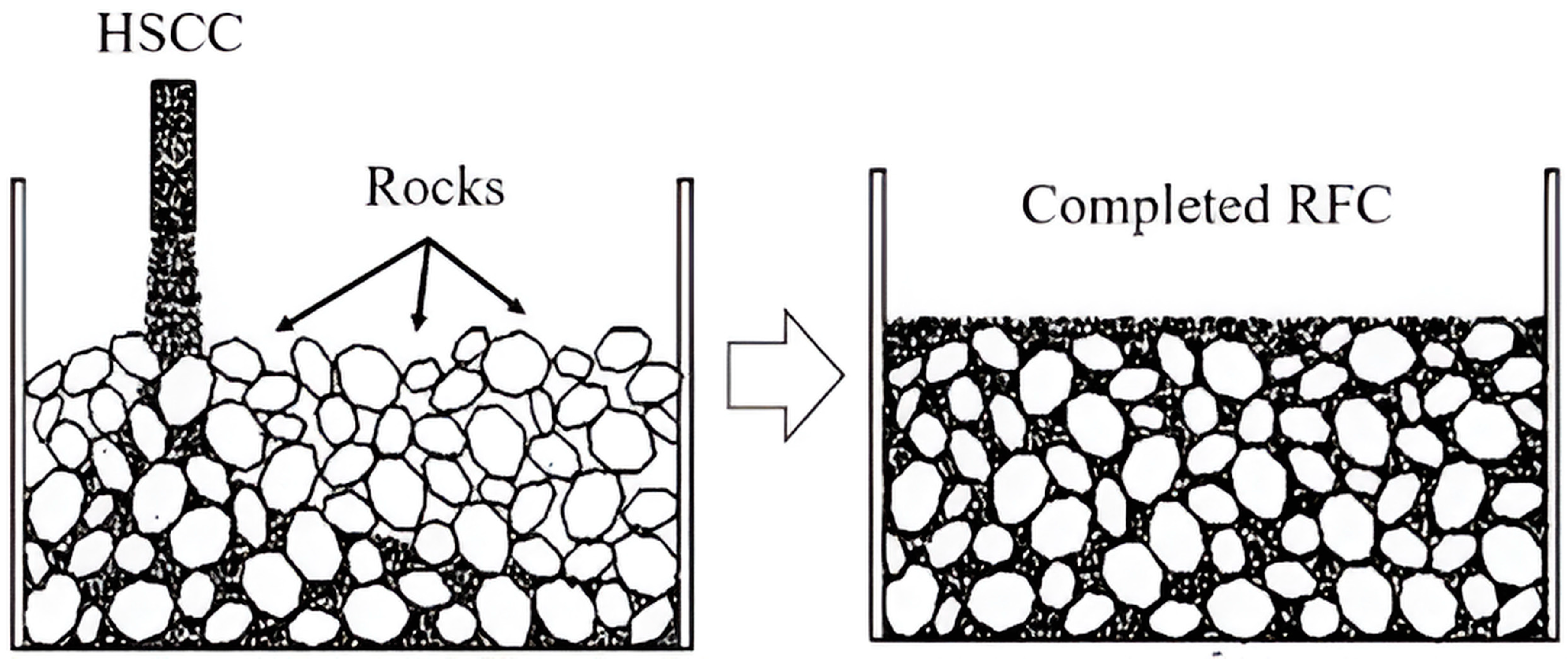
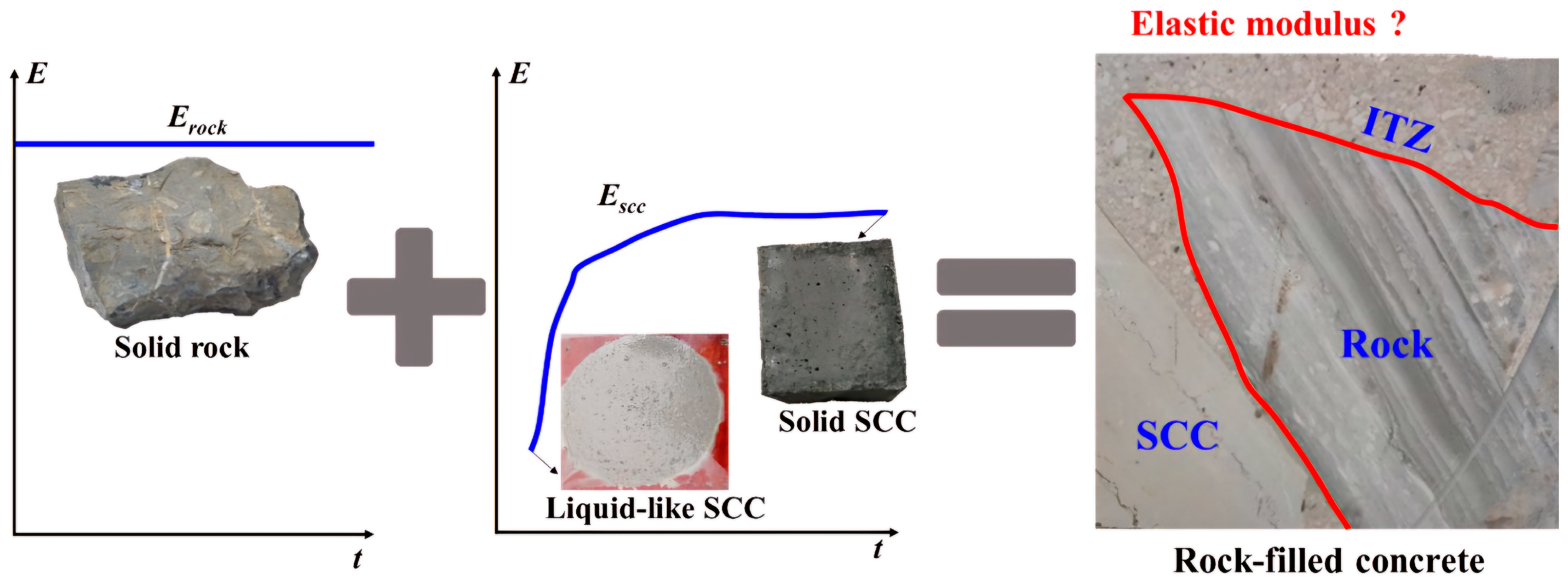
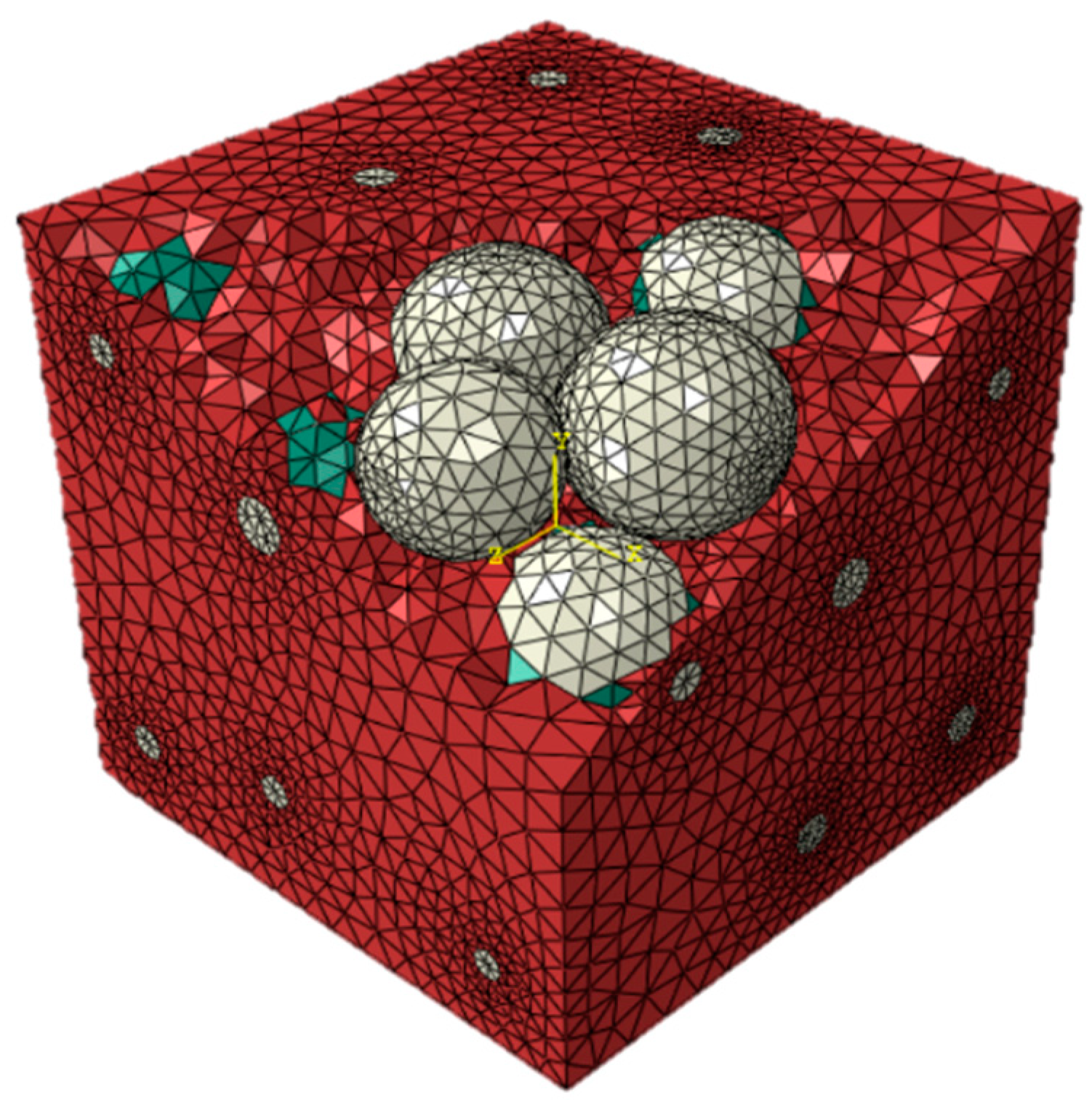

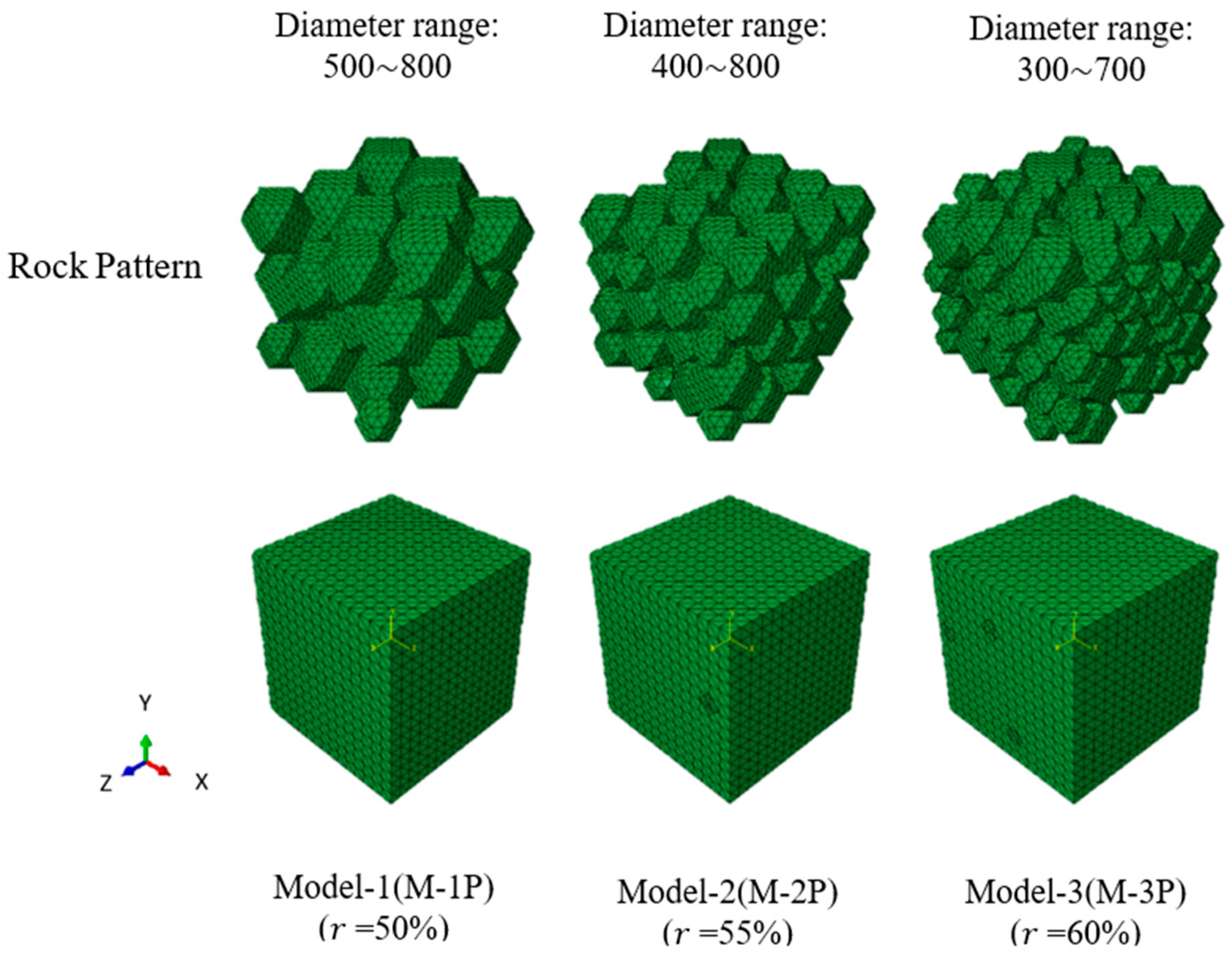

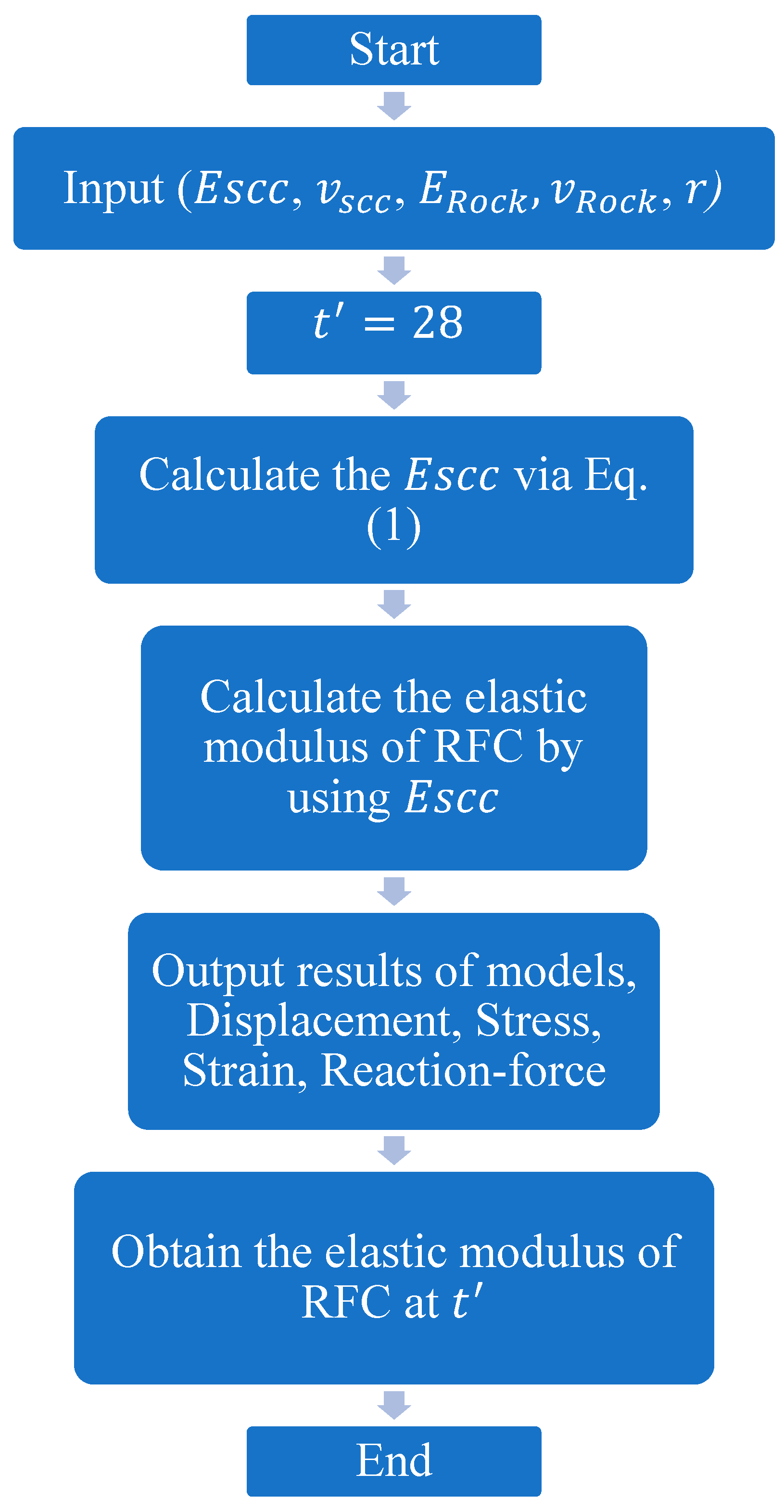
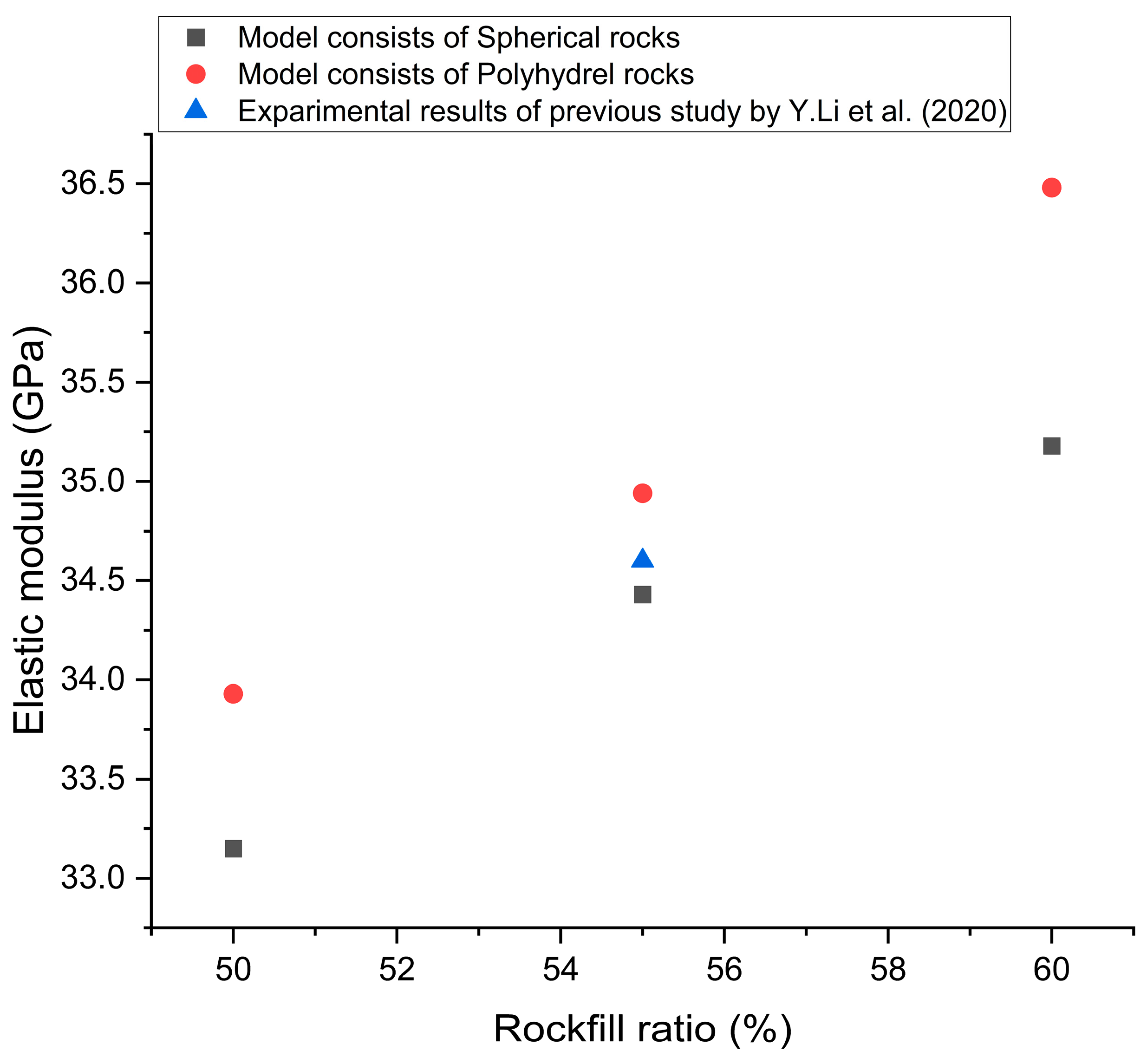

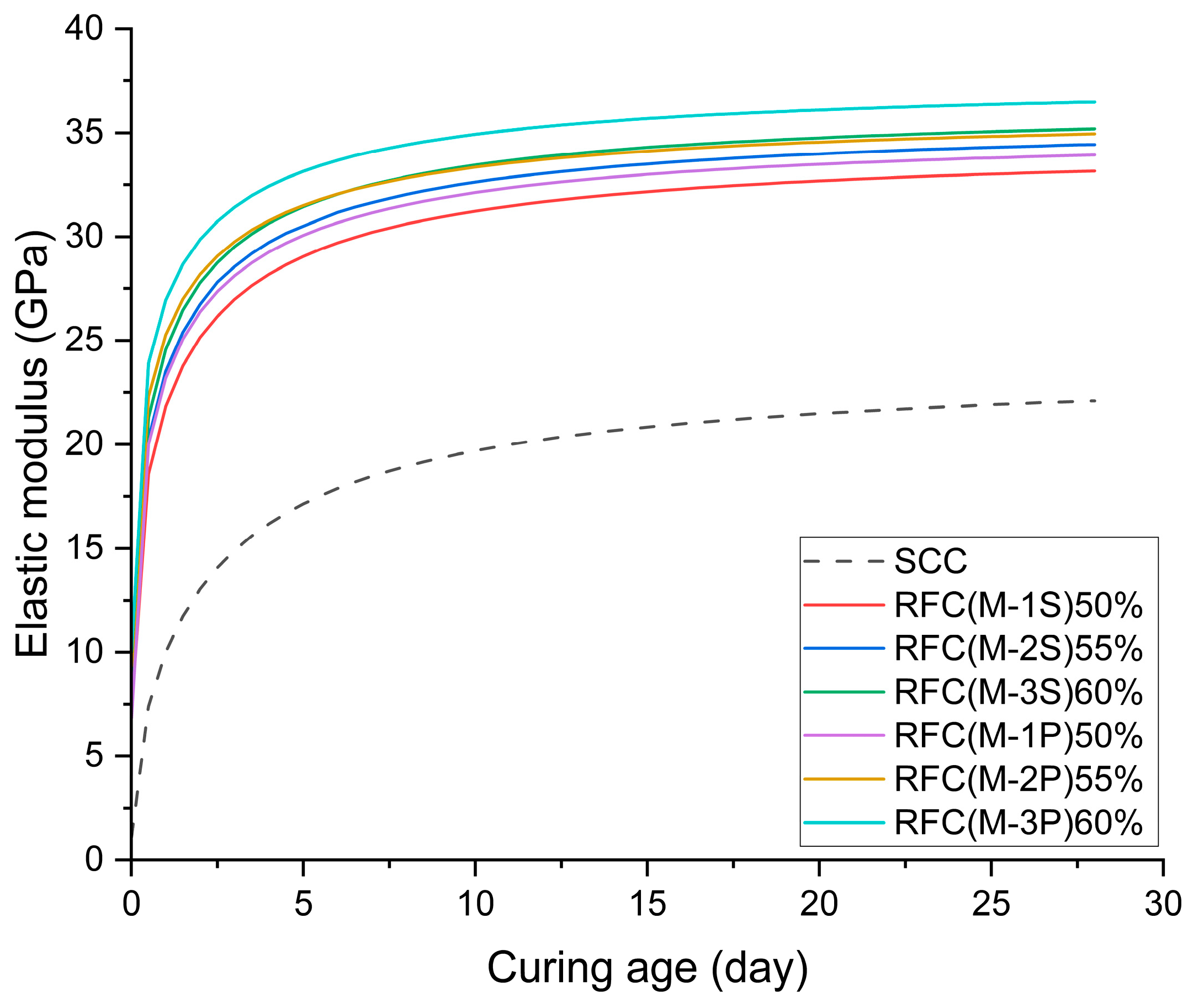
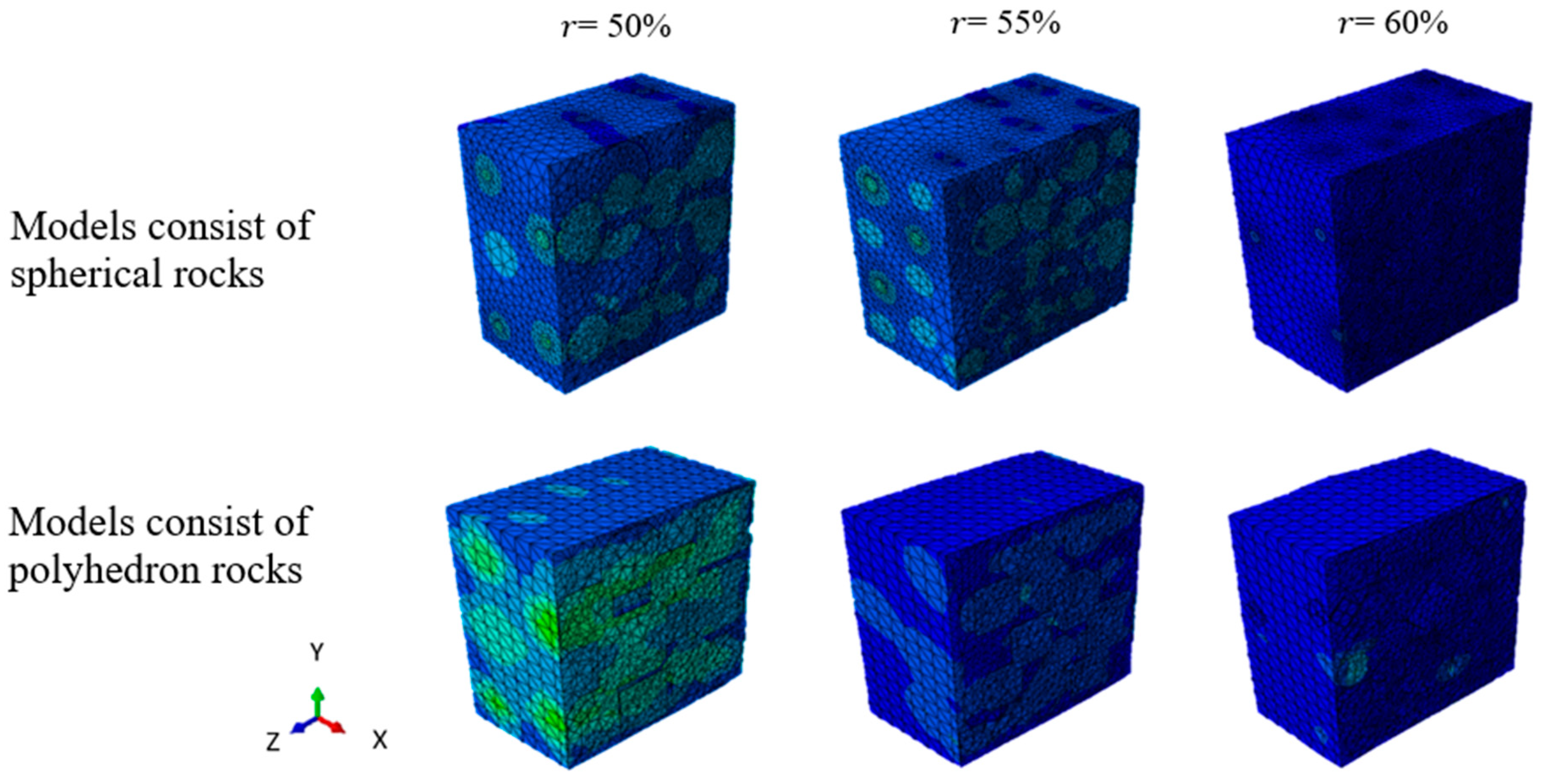
| E (GPa) | v | P (kg/m³) | |
|---|---|---|---|
| Rock | 53.8 | 0.25 | 2725 |
| SCC | 22.09 | 0.167 | 2300 |
| ITZ | 22.09 | 0.167 | 2300 |
| Characteristics | SCC | Rocks | RFC |
|---|---|---|---|
| Model-1 | 50% | 50% | 100% |
| (M-1S and M-1P) | |||
| Model-2 | 45% | 55% | 100% |
| (M-2S and M-2P) | |||
| Model-3 | 40% | 60% | 100% |
| (M-3S and M-3P) |
| Rockfill Ratio | SCC (GPa) | Models Consist of Spherical Rocks (GPa) | Models Consist of Polyhedron Rocks (GPa) |
|---|---|---|---|
| r = 50% | 22.09 | 33.15 | 33.93 |
| r = 55% | 22.09 | 34.43 | 34.94 |
| r = 60% | 22.09 | 35.18 | 36.48 |
Disclaimer/Publisher’s Note: The statements, opinions and data contained in all publications are solely those of the individual author(s) and contributor(s) and not of MDPI and/or the editor(s). MDPI and/or the editor(s) disclaim responsibility for any injury to people or property resulting from any ideas, methods, instructions or products referred to in the content. |
© 2024 by the authors. Licensee MDPI, Basel, Switzerland. This article is an open access article distributed under the terms and conditions of the Creative Commons Attribution (CC BY) license (https://creativecommons.org/licenses/by/4.0/).
Share and Cite
Ihteshaam, M.I.; Jin, F.; Xu, X. A Mesoscale Comparative Analysis of the Elastic Modulus in Rock-Filled Concrete for Structural Applications. Buildings 2024, 14, 3171. https://doi.org/10.3390/buildings14103171
Ihteshaam MI, Jin F, Xu X. A Mesoscale Comparative Analysis of the Elastic Modulus in Rock-Filled Concrete for Structural Applications. Buildings. 2024; 14(10):3171. https://doi.org/10.3390/buildings14103171
Chicago/Turabian StyleIhteshaam, Muhammad Ibrar, Feng Jin, and Xiaorong Xu. 2024. "A Mesoscale Comparative Analysis of the Elastic Modulus in Rock-Filled Concrete for Structural Applications" Buildings 14, no. 10: 3171. https://doi.org/10.3390/buildings14103171
APA StyleIhteshaam, M. I., Jin, F., & Xu, X. (2024). A Mesoscale Comparative Analysis of the Elastic Modulus in Rock-Filled Concrete for Structural Applications. Buildings, 14(10), 3171. https://doi.org/10.3390/buildings14103171





